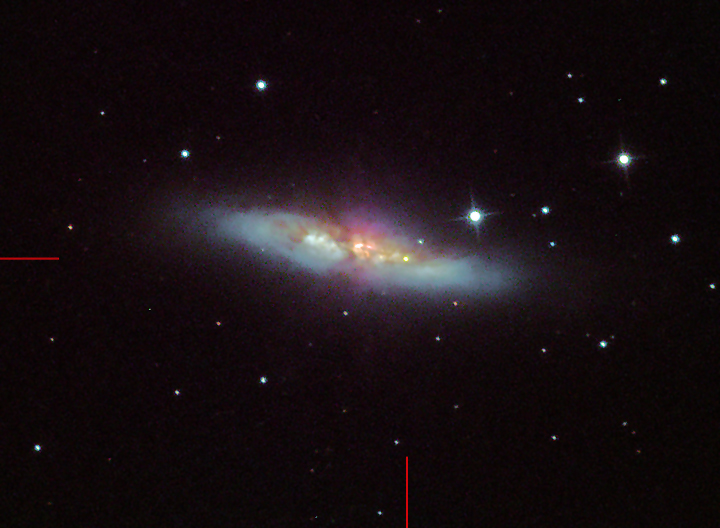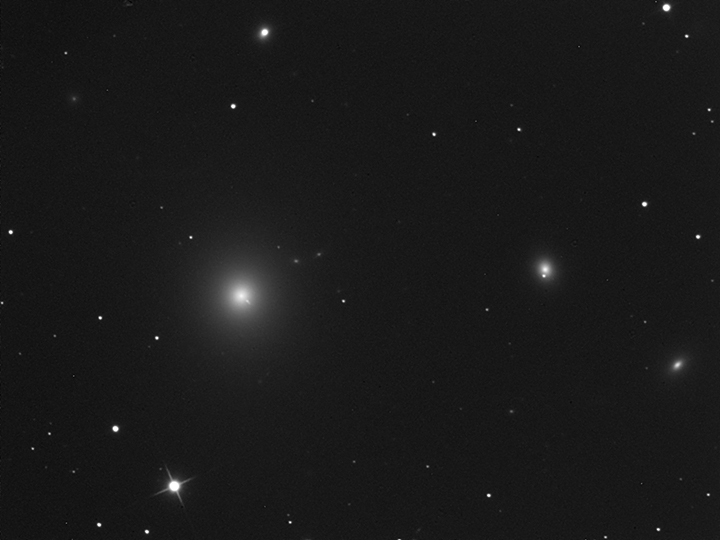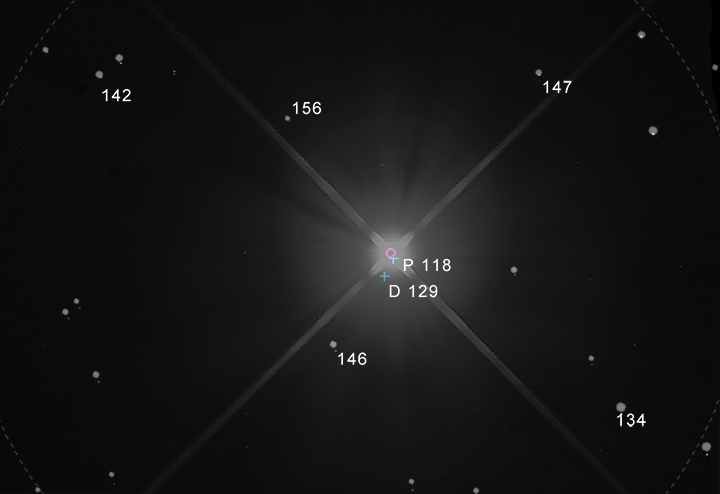4/10/2014. Two galaxies: catching up with SN 2014J and a reality check on Roland Christen's photo of the M87 jet. I've been going after bright targets under the bright Moon.

M82, SN 2014J marked
6x300s L, 4x300s RGB (1h 30m total)
Last night, I shot M82 to check on SN 2014J and found excellent seeing (for here: 2.7" PSFs). This gave me high hopes for a decent image of M87's jet (inspired by a photo Roland Christen posted a few nights back) but I saw little return on my trouble -- it's there (the short streak at the 4 o'clock position in the image below), but for some reason resolution at that time in that part of the sky was lousy. The seeing is at least twice as good as the previous night, but still... Ninety minutes of RGB hints that color will serve the subject well, but I need a better luminance frame for a base. Maybe I should try a very tall stack of very short subframes; the visible aspect of the relativistic jet coming off the multi-billion solar mass black hole in M87's core shows up in 30 seconds. Don't be reluctant to shoot it in bright skies or as a casual target with short exposures when the seeing seems promising.

M87
7x300s L (35m)
4/11/2014. Housekeeping, loose ends, etc. Tweaking collimation. Cleaning optics. I dumped the years-old weatherstripping I taped in place to hold the cap on the R-C and replaced it with self-stick Velcro (~2 inches in one spot, 3/4 inches in two others). Press the cap on in one orientation and it's loosely held by friction; align the velcro and it's on good and tight.
I shot NGC 2158 for its own sake and to give CCDInspector a rich field for analysis. It showed that collimation is now very, very good and tilt is negligible. So why aren't my images tightening up any better than they are? The last several of all-night image sequences are especially, consistently, unaccountably awful. This morning, I hurried out to check the 'scope early. The primary mirror seemed much cloudier than I expected, much worse than it looks by day; perhaps surface muck is exacerbating the otherwise mild effects of dew. That's what it looked like, so I cleaned the primary and we'll see what happens next.
Charging the batteries in the mobile observatory (aka, the thing, the RV, etc), spritzing Fabreeze around the interior, topping off the tires, exercizing the generator, replacing the AAA's in the thermostat, fixing up the side mirrors -- you'd think I might have plans for it. Which I do, but not immediately.
4/12/2014. Tonight's quest: the hurtling moons of Barsoom. I always thought the phrase belonged to Edgar Rice Burroughs in "A Princess of Mars," the first John Carter tale from 1917. But no, I downloaded the Project Gutenberg text and found that lots of things hurtle in that novel, but "the moons of Barsoom" do not. Phobos, the inner moon, is said to hurtle (and more than once), but not Deimos or both moons together (there's a free Kindle edition, have fun). I suspect now that the phrase is Saint Carl's. It has a kind of Saganesque boom and reverb to it, doesn't it? Say it like Bullwinkle if you doubt.
ETA: In The Cosmic Connection, and probably somewhere in "Cosmos" as well, Sagan attributes the phrase to Burroughs. I never saw the original "Cosmos" (!) but I bought TCC the day it came out. From TCC: "But the name invented by Burroughs that has haunted me across the years is the name he imagined the Martians gave to Mars: Barsoom. And it was one phrase
of his more than any other that captured my imagination: 'The hurtling moons of Barsoom.'"
Sagan's book is now available as a free PDF if you hunt for it, and my goodness a lot has changed since TCC was new! [More on the hurtling moons down below...]
Anyway, with Mars near opposition and nearer Earth than usual, it's a good time to look for its moons. Mars is well to the south and does not clear the pines except as it rises through a gap to the southeast. I had thirty minutes to shoot after Mars rose above the tops of one stand and before it passed into the boughs of another. Guide 9.0 said the outer, dimmer moon would be well separated from the planet during that interval, but the inner, brighter moon -- the hurtling one -- was hopeless.
Just so. Ten, 10s frames at -20°C with a fresh dark did the trick nicely. Judicious stretching and aggressive deconvolution are important, too. Here's the full frame, followed by the same image overlayed with a a map of the immediate area from Guide (drawn at the midpoint of the stack, to insure proper orientation and to indicate exactly where to look for Deimos), and finally a crop of the region around Mars, brutally sharpened, with RGB data added:


Field stars labelled with magnitudes from the HST Guidestar catalog, AAVSO style (e.g., "134" means magnitude 13.4). The positions of Mars, Phobos and Deimos are marked for the midpoint of the sequence of 10s exposures.

Cluros, the small outer moon of Barsoom
(aka Deimos, the small outer moon of Mars)
10x10s L, 5x10s RGB
The noise coming off to the left is from a stray pine sprig that the last few subframes caught shining in the Marslight. I reprocessed the 10s frames, omitting the last four luminance frames which showed this scattered light. This time I was also careful to be more restrained in my deconvolution efforts. I think the result is considerably cleaner:

Deimos, the small outer moon of Mars
6x10s L, 5x10s RGB

Deimos, the small outer moon of Mars
Right-click (view image) for full-sized image.
6x10s L, 5x10s RGB
Ha! And something else: the first and last of those six frames were made 4m30s apart. During that time, Deimos moved a little over 2 arc seconds which is just about the FWHM size of PSFs on the deconvolved image. So Deimos's image should be measurably softer, "trailed" or at least eccentric. The sigma-clip combination was probably working a little against me! I need to try it again using simple summation. [Nice theory, but sigma clip gives me the crispest Deimos image; and by measuring PSFs from around the image, Deimos is softer, by a factor of about two, but it shows no elongation. So back to the drawing board on that one.]
Still waiting for a clear spell with Phobos (aka Thuria) near elongation while the planet is not embedded in pine trees, and then we will have a go at the other hurtling moon of Barsoom.
The moons having been found, here begins a search for the phrase, "The hurtling moons of Barsoom:"
From The Chessmen of Mars:
Gently they drifted beneath the hurtling moons above the mad shadows of a Martian night.
and later
For some time they stood upon the roof beneath the brilliant stars and hurtling moons of dying Mars, laying their plans against the time that Tara of Helium should be brought from the high tower to the throne room of O-Tar.
From The Gods of Mars:
"Should he die before the expiration of the thousand years from the birth of the thern whose immortality abides within him then the soul passes into a great white ape, but should the ape die short of the exact hour that terminates the thousand years the soul is for ever lost and passes for all eternity into the carcass of the slimy and fearsome silians whose wriggling thousands seethe the silent sea beneath the hurtling moons when the sun has gone and strange shapes walk through the Valley Dor."
Then the moons come; the mysterious, magic moons of Mars, hurtling like monster meteors low across the face of the planet.
From Thuvia, Maid of Mars:
With a word of farewell he touched the button which controlled the repulsive rays, and as the flier rose lightly into the air, the engine purred in answer to the touch of his finger upon a second button, the propellers whirred as his hand drew back the speed lever, and Carthoris, Prince of Helium, was off into the gorgeous Martian night beneath the hurtling moons and the million stars.
From Warlord of Mars:
In the shadows of the forest that flanks the crimson plain by the side of the Lost Sea of Korus in the Valley Dor, beneath the hurtling moons of Mars, speeding their meteoric way close above the bosom of the dying planet, I crept stealthily along the trail of a shadowy form that hugged the darker places with a persistency that proclaimed the sinister nature of its errand.
05/06/2014. Deimos is easy. Well, easy-ish. I shut down the control computer and went outside to park the 'scope for the night when I saw Mars shining through the gap just west of Meridian Pine. I knew the sky was reasonably steady and, on a lark, I decided to take some images to see if I might luck into one (or two) of its moons. I restarted the computer, re-cooled the camera to -20°C, and took ten-second, five-second, and three-second sequences of a dozen images each.
Mars has moved on past opposition and the moons are marginally fainter (13.1 vs 12.8 for Deimos), but Mars is reduced even more (-1.1 vs -1.6 according to Guide). That plus the decent focus I'd achieved on M66 earlier while testing tweaked polar alignment easily overcame the slightly reduced elongation distances. Deimos popped out of the stack of ten-second exposures:

It even appeared in individual three-second frames. That verified that the shorter exposure is enough to capture Phobos, a magnitude brighter, when it is well positioned. In fact, it suggests that one second exposures should do it, but I want both moons in one frame, so I'll probably use runs of two- or three-second exposures to try for both when both are at suitable distances from the planet and the planet is in the clear and the weather allows (a conjunction of happy circumstances which may not happen this season). Here's a stack of 12, three-second frames at the same scale and orientation as the ten-second stack (so, unmarked):

I processed this a little differently: I applied 20 passes of L-R deconvolution (9x9) prior to histogram stretching, then 10 more (7x7) after. Worked nicely. Natural PSF's were in the 2.8 - 3.1 arc second regime; after deconvolution, stellar PSF's came down to 0.9 - 1.1!
Note that for Phobos, it may matter where in the camera's FOV the moon is. That's because overflowing electron wells in the CCD flood one side of a bright source (like Mars) more than the other. ABG the SBIG ST2000XM may be, but the bloom suppression is not 100% effective. For the record, the photos immediately above were made with the camera oriented to 270° and the preferred, sharp-edged, darker side of the photon spill lies to the west, on the same side as Deimos. That is, with the camera oriented to 270°, photons spill east (easy mnemonic: photons spill away from the index mark). This effect is really only apparent when the image is aggressively (excessively?) deconvolved and stretched -- which may happen routinely when hunting Phobos.